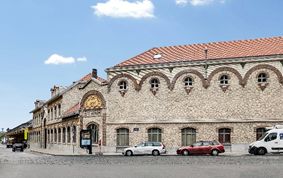A former aperitif factory has become a hub for SMEs and cultural activities that contributes to job creation, social cohesion and the development of a circular economy in the Brussels Region.
- 14 October 2021
'It is the ideal place to do your sustainable and local shopping, taste artisanal products, to have your bike repaired or to think about your well-being.'
Be-Here offers space to SMEs active in sectors like sustainable food, and social enterprises, while also attracting new economic activity to Brussels. The site offers semi-industrial spaces for production, storage and sales, along with offices and communal infrastructure. The latter includes internet access, cleaning services, meeting rooms, and logistics facilities like loading bays and a goods elevator.
A sustainable village
The Be-Here site describes itself as a sustainable village in the city and is located at 148-150 Rue Dieudonné Lefèvre, near the Tour and Taxis exhibition and trade centre in Laeken. Its current tenants include five cultural organisations, among them a Baroque music ensemble; a non-profit organisation that oversees theatre productions, exhibitions and workshops; and an orchestra that supports the development of young Belgian musicians.
The food and drink offering includes an organic fruit and vegetable market, a zero-packaging chocolate maker, a granola store, two breweries, a caterer, an artisanal organic biscuit maker, and two spaces dedicated to the production and sale of fermented food. There are also a sneaker bar, a bicycle sales and repair shop, and a physiotherapist.
The site has workshops of between 200 m² to 620 m² in area, modular semi-industrial spaces for production and sales, offices of between 13m² to 65m², two meetings rooms of 30m2 and 70m2 and a 1200m2 hall. These spaces can be rented for events.
From Byrrh to social action
The buildings were classified a listed monument in May 1997. The Public Welfare Service (CPAS) of Brussels bought the buildings with the help of the ERDF in 2007. A total area of 10 231 m2 was renovated and restored and the site opened for business in March 2019.
The façades feature opus incertum (irregular work) masonry, cleft cladding and sgraffito – a wall decoration technique where layers of plaster tinted in contrasting colours are applied to a moistened surface.
According to visit.brussels, the Byrrh buildings were designed by Parisian architect Anatole Laquerrière. He was commissioned by French brothers Simon and Pallade Violet, travelling merchants of textiles, wine and haberdashery in the Rousillon region, who established a boutique in Thuir, France.
The buildings in Brussels were used to produce and sell the Byrrh beverage, an aromatised wine they concocted in 1866. They marketed it as a 'tonic and hygienic cinchona wine', and sold it as a medicinal product in pharmacies to avoid competition with local aperitif producers.
They registered the trademark in Perpignan, France, in 1873. It grew in popularity worldwide and by 1910, the Violet’s company had 750 employees and was distributing more than 30 million litres of Byrrh annually.
Be-Here is managed by Brussels Business Hubs which supports economic activities in the Belgian capital. It used experience acquired during the Ateliers des Tanneurs project to contribute to the development of Be-Here.
Total investment and EU funding
Total investment for the project “Byrrh: Be-Here business support”, was EUR 19 950 000, with the EU’s European Regional Development Fund contributing EUR 5 300 000 through the “Brussels Capital Region” Operational Programme for the 2007-2013 programming period.

